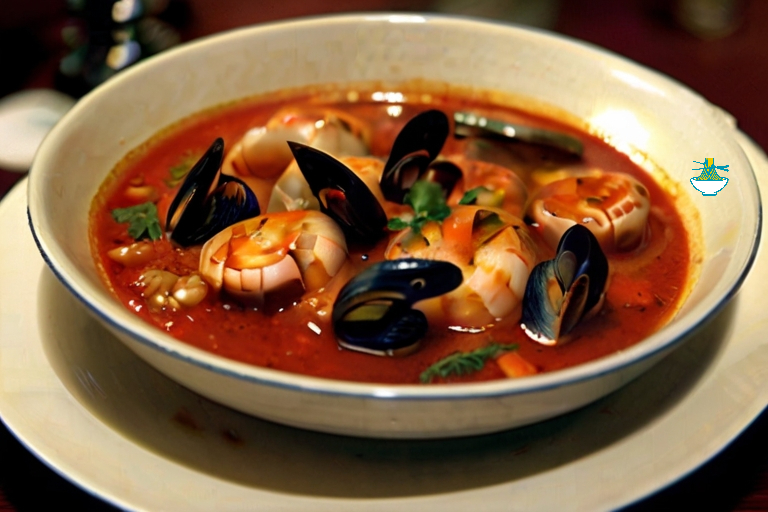Dive into the culinary delights of Croatia with Brudet, a traditional Adriatic seafood stew bursting with rich flavors and cultural heritage. This hearty dish features a tantalizing blend of fresh fish, shellfish, tomatoes, garlic, onions, and aromatic herbs, simmered to perfection in a savory broth. Served hot over a bed of polenta or crusty bread, Brudet showcases the coastal charm of Croatian cuisine, offering a taste of the Adriatic Sea in every spoonful. Whether enjoyed at a seaside tavern or prepared at home, this iconic dish promises a delightful gastronomic journey through the sun-kissed shores of Croatia.
Here's a recipe for Croatian Brudet:
Ingredients:
- 1 kg (2.2 lbs) mixed seafood (such as fish fillets, shrimp, calamari, mussels, and clams), cleaned and cut into bite-sized pieces
- 4-5 ripe tomatoes, chopped (or 1 can of diced tomatoes)
- 2 onions, thinly sliced
- 4 cloves of garlic, minced
- 1/4 cup olive oil
- 1 cup fish or seafood stock
- 1/2 cup white wine
- 2 tablespoons tomato paste
- 1 bay leaf
- 1 teaspoon dried oregano
- 1 teaspoon dried thyme
- Salt and pepper to taste
- Fresh parsley, chopped (for garnish)
- Crusty bread or polenta (for serving)

Instructions:
1- Heat the olive oil in a large pot over medium heat. Add the sliced onions and cook until softened, about 5 minutes.
2- Stir in the minced garlic and cook for another minute until fragrant.
3- Add the chopped tomatoes (or canned tomatoes) to the pot and cook for 5-7 minutes, until they begin to break down and release their juices.
4- Pour in the white wine and fish or seafood stock, and add the tomato paste, bay leaf, dried oregano, and dried thyme. Season with salt and pepper to taste.
5- Bring the mixture to a simmer and let it cook for about 15 minutes, allowing the flavors to meld together and the sauce to thicken slightly.
6- Once the sauce has thickened, add the mixed seafood to the pot, stirring gently to combine. Cover the pot and simmer for another 10-15 minutes, or until the seafood is cooked through and tender.
7- Taste and adjust the seasoning if necessary. Remove the bay leaf from the pot.
8- Serve the Brudet hot, garnished with freshly chopped parsley. Enjoy with crusty bread or polenta to soak up the flavorful sauce.
Note: Feel free to customize this recipe by using your favorite combination of seafood. Additionally, you can add a splash of vinegar or lemon juice for a touch of acidity, if desired. Enjoy your Croatian Brudet!
Nutritional Values:
Providing precise nutritional values for the ingredients in Croatian Brudet can be challenging due to variations in portion sizes, specific types of seafood used, and differences in brands of ingredients. However, I can offer approximate nutritional information for some of the main ingredients commonly used in this dish:
Mixed seafood (fish fillets, shrimp, calamari, mussels, clams):
- Protein: Varies depending on the type of seafood, but generally high in protein.
- Fat: Varies depending on the type of seafood, but often low in fat.
- Carbohydrates: Minimal to none.
- Calories: Varies depending on the type and portion size of seafood.
benefits:
- Excellent source of high-quality protein, essential for muscle repair and growth.
- Rich in omega-3 fatty acids, which support heart health and cognitive function.
- Provides essential vitamins and minerals such as vitamin D, vitamin B12, iodine, and selenium.
Tomatoes:
- Protein: Approximately 1 gram per medium tomato.
- Fat: Minimal, less than 1 gram per medium tomato.
- Carbohydrates: Approximately 5-6 grams per medium tomato.
- Calories: Approximately 25-30 calories per medium tomato.
benefits:
- High in vitamin C, an antioxidant that boosts the immune system and promotes skin health.
- Contains lycopene, a powerful antioxidant linked to reduced risk of certain cancers and heart disease.
- Good source of potassium, which helps regulate blood pressure and muscle function.
Onions:
- Protein: Approximately 1 gram per medium onion.
- Fat: Minimal, less than 1 gram per medium onion.
- Carbohydrates: Approximately 10-12 grams per medium onion.
- Calories: Approximately 45-50 calories per medium onion.
benefits:
- Rich in antioxidants such as quercetin, which may reduce inflammation and lower the risk of chronic diseases.
- Contains prebiotic fibers that support gut health and digestive function.
- Provides sulfur compounds that may have anti-inflammatory and anti-cancer properties.
Garlic:
- Protein: Approximately 1 gram per clove.
- Fat: Minimal, less than 1 gram per clove.
- Carbohydrates: Approximately 1 gram per clove.
- Calories: Approximately 4-5 calories per clove.
benefits:
- Known for its immune-boosting properties due to its high content of allicin, a sulfur-containing compound.
- Has antibacterial and antiviral properties that may help fight infections.
- Supports heart health by lowering cholesterol and blood pressure levels.
Olive oil:
- Protein: None.
- Fat: Approximately 14 grams per tablespoon.
- Carbohydrates: None.
- Calories: Approximately 120 calories per tablespoon.
benefits:
- Rich in monounsaturated fats, which can improve heart health by reducing LDL cholesterol levels.
- Contains antioxidants such as vitamin E and polyphenols, which protect cells from damage caused by free radicals.
- May have anti-inflammatory effects and contribute to better skin health.
White wine:
- Protein: None.
- Fat: None.
- Carbohydrates: Varies depending on the type and sweetness of the wine, typically around 4-5 grams per 5-ounce serving.
- Calories: Approximately 120-130 calories per 5-ounce serving.
benefits:
- Contains antioxidants like resveratrol, which may have anti-inflammatory and heart-protective effects.
- Moderate consumption has been linked to a reduced risk of cardiovascular disease.
- Can enhance the flavor of dishes and contribute to a more enjoyable dining experience.
Please note that these values are approximate and can vary based on factors such as ingredient size, preparation methods, and specific brands used. If you require more precise nutritional information, I recommend using a reliable nutrition calculator or consulting with a registered dietitian.


Comments